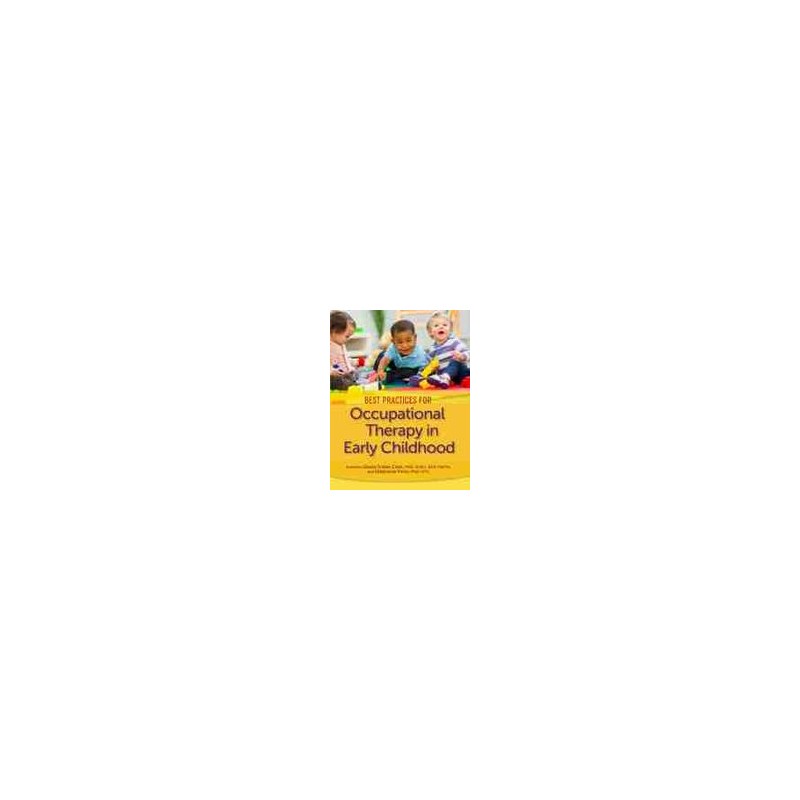Opis
Staying current on new evidence and practice across the field of early childhood can be challenging and time consuming. This comprehensive new text covers all aspects of occupational therapy in early childhood across early intervention, preschools, and health care, providing the most effective, evidence-guided practices to equip practitioners working with young children. Best Practices for Occupational Therapy in Early Childhood addresses legislative, professional, and contextual influences on providing occupational therapy to young children and their families and promotes coordination of services across settings.Best Practices for Occupational Therapy in Early Childhood prepares practitioners to support and enhance outcomes for occupational therapy’s youngest clients and their families.
Szczegóły produktu
Indeks
90342
EAN13
9781569004982
ISBN
9781569004982
Opis
Rok wydania
2021
Numer wydania
1
Oprawa
miękka foliowana
Liczba stron
426
Section I. Understanding Early Childhood and Occupational Therapy’s Role Chapter 1. History of Occupational Therapy Services in Early Childhood Chapter 2. Influences From Early Childhood Professional Organizations and Technical Assistance Centers Chapter 3. Best Practices in Personnel Preparation for Occupational Therapists and Occupational Therapy Assistants Chapter 4. Best Practices for Occupational Therapy Assistants in Early Childhood Chapter 5. Best Practices for Occupational Therapy Practitioners in Leadership Roles Chapter 6. Best Practices in Data-Based Decision Making Chapter 7. Best Practices for Assistive Technology Chapter 8. Best Practices in Supporting Family Partnerships Chapter 9. Best Practices in Collaborating With Community, School, and Health Care Partners Chapter 10. Best Practices in Early Childhood Transitions Section II. Early Development Chapter 11. Brain Development in the Early Years Chapter 12. Early Childhood Mental Health Chapter 13. Understanding Early Literacy Development Section III. Considerations for Early Intervention:: IDEA Part C Chapter 14. Understanding Part C:: Early Intervention Law and the Individualized Family Service Plan (IFSP) Process Chapter 15. Best Practices in Early Intervention Screening and Evaluation Chapter 16. Best Practices in Intervention Under Part C Chapter 17. Best Practices in Documenting Early Intervention Services and Outcomes Section IV. Considerations for Preschool:: IDEA Part B Chapter 18. Understanding Preschool Laws and the Individualized Education Program Process Chapter 19. Best Practices in Preschool Screening and Evaluation Chapter 20. Best Practices in Intervention in Preschool Chapter 21. Best Practices in Documentation of Preschool Services and Outcomes Section V. Considerations for Medical and Health Care Settings Chapter 22. Understanding Health Care Requirements, Process, and Billing Chapter 23. Best Practices in Evaluation in Health Care Settings Chapter 24. Best Practices in Health Care Interventions for Developmental Conditions Chapter 25. Best Practices in Health Care Intervention for Acquired Conditions Chapter 26. Best Practices in Documentation of Health Care Services and Outcomes Section VI. Evidence-Guided Practice:: Addressing Evaluation and Intervention Chapter 27. Best Practices in Supporting Activities of Daily Living (Adaptive Skills) Chapter 28. Best Practices in Supporting Mealtimes and Nutritional Needs (Adaptive Skills) Chapter 29. Best Practices in Supporting Learning and Literacy Skills (Cognitive Skills) Chapter 30. Best Practices in Supporting Development of Fine and Visual–Motor Coordination (Physical Skills) Chapter 31. Best Practices in Supporting Large Motor Coordination (Physical Skills) Chapter 32. Best Practices in Supporting Social Participation (Communication) Chapter 33. Best Practices in Supporting Social, Emotional, and Self-Regulation Skills (Social–Emotional Skills) Chapter 34. Best Practices in Supporting Play and Leisure Activities Chapter 35. Best Practices in Supporting Children Who Are Deaf and Hard of Hearing Chapter 36. Best Practices in Supporting Children With Visual Impairments Chapter 37. Best Practices in Supporting Children With Health Needs Chapter 38. Best Practices in Supporting Children With ASD and ADHD Chapter 39. Best Practices Supporting Families of Children With Prenatal Substance Exposure and Postnatal Trauma Appendix A. Guidelines for Occupational Therapy Services in Early Intervention and Schools Appendix B. Evidence-Based Practice and Occupational Therapy Appendix C. AOTA Occupational Profile Template Appendix D. Occupational Therapy Intervention Plan Appendix E. AOTA Resources for Practitioners and Families Appendix F. Examples of Assessments for Early Childhood (Birth–5 Years) Appendix G. Sample Early Intervention Team Report Appendix H. Sample Initial Preschool Team Evaluation Report Appendix I. Sample Occupational Therapy Evaluation in Health Care Appendix J. Occupational Therapy Telehealth Practices in Early Childhood


 Dostawa
Dostawa
 Płatność
Płatność
 Zwroty
Zwroty
